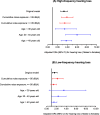Sex differences in noise-induced hearing loss: a cross-sectional study in China
- PMID: 33676563
- PMCID: PMC7937304
- DOI: 10.1186/s13293-021-00369-0
Sex differences in noise-induced hearing loss: a cross-sectional study in China
Abstract
Background: Significant sex differences exist in hearing physiology, while few human studies have investigated sex differences in noise-induced hearing loss (NIHL), and the sex bias in previous studies resulted in inadequate female data. The study aims to investigate sex differences in the characteristics of NIHL to provide insight into sex-specific risk factors, prevention strategies and treatment for NIHL.
Methods: This cross-sectional study included 2280 industrial noise-exposed shipyard workers (1140 males and 1140 females matched for age, job and employment length) in China. Individual noise exposure levels were measured to calculate the cumulative noise exposure (CNE), and an audiometric test was performed by an experienced technician in a soundproof booth. Sex differences in and influencing factors of low-frequency (LFHL) and high-frequency hearing loss (HFHL) were analyzed using logistic regression models stratified by age and CNE.
Results: At comparable noise exposure levels and ages, the prevalence of HFHL was significantly higher in males (34.4%) than in females (13.8%), and males had a higher prevalence of HFHL (OR = 4.19, 95% CI 3.18 to 5.52) after adjusting for age, CNE, and other covariates. Sex differences were constant and highly remarkable among subjects aged 30 to 40 years and those with a CNE of 80 to 95 dB(A). Alcohol consumption might be a risk factor for HFHL in females (OR = 3.12, 95% CI 1.10 to 8.89).
Conclusions: This study indicates significant sex differences in NIHL. Males are at higher risk of HFHL than females despite equivalent noise exposure and age. The risk factors for NIHL might be different in males and females.
Keywords: Hearing loss; Occupational noise exposure; Sex differences.
Conflict of interest statement
The authors declare that they have no competing interests.
Figures



Similar articles
-
Effectiveness of Kurtosis-Adjusted Cumulative Noise Exposure in Assessing Occupational Hearing Loss Associated With Complex Noise.Ear Hear. 2023 Jul-Aug 01;44(4):865-876. doi: 10.1097/AUD.0000000000001327. Epub 2023 Jan 11. Ear Hear. 2023. PMID: 36629325 Free PMC article.
-
[Investigation into the relationship between mitochondrial 12 S rRNA gene, tRNA gene and cytochrome oxidase Ⅱ gene variations and the risk of noise-induced hearing loss].Zhonghua Yu Fang Yi Xue Za Zhi. 2017 Jan 6;51(1):34-40. doi: 10.3760/cma.j.issn.0253-9624.2017.01.008. Zhonghua Yu Fang Yi Xue Za Zhi. 2017. PMID: 28056268 Chinese.
-
The role of kurtosis and kurtosis-adjusted energy metric in occupational noise-induced hearing loss among metal manufacturing workers.Front Public Health. 2023 Jun 29;11:1159348. doi: 10.3389/fpubh.2023.1159348. eCollection 2023. Front Public Health. 2023. PMID: 37457253 Free PMC article.
-
Occupational Hearing Loss Associated With Non-Gaussian Noise: A Systematic Review and Meta-analysis.Ear Hear. 2021 Nov-Dec 01;42(6):1472-1484. doi: 10.1097/AUD.0000000000001060. Ear Hear. 2021. PMID: 34010248 Free PMC article.
-
Occupational noise-induced hearing loss in China: a systematic review and meta-analysis.BMJ Open. 2020 Sep 28;10(9):e039576. doi: 10.1136/bmjopen-2020-039576. BMJ Open. 2020. PMID: 32988950 Free PMC article.
Cited by
-
Dose-Dependent Pattern of Cochlear Synaptic Degeneration in C57BL/6J Mice Induced by Repeated Noise Exposure.Neural Plast. 2021 Jun 9;2021:9919977. doi: 10.1155/2021/9919977. eCollection 2021. Neural Plast. 2021. PMID: 34221004 Free PMC article.
-
Optimizing a Classification Model to Evaluate Individual Susceptibility in Noise-Induced Hearing Loss: Cross-Sectional Study.JMIR Public Health Surveill. 2024 Nov 14;10:e60373. doi: 10.2196/60373. JMIR Public Health Surveill. 2024. PMID: 39629704 Free PMC article.
-
Awareness of and the relationship between noise-induced hearing loss and the use of personal listening devices in Jazan region, Saudi Arabia.Front Public Health. 2025 Feb 21;13:1505442. doi: 10.3389/fpubh.2025.1505442. eCollection 2025. Front Public Health. 2025. PMID: 40061459 Free PMC article.
-
Easy as 1-2-3: Development and Evaluation of a Simple yet Valid Audiogram-Classification System.Trends Hear. 2024 Jan-Dec;28:23312165241260041. doi: 10.1177/23312165241260041. Trends Hear. 2024. PMID: 38870447 Free PMC article.
-
Global, Regional, and National Burdens of Hearing Loss for Children and Adolescents from 1990 to 2019: A Trend Analysis.Trends Hear. 2024 Jan-Dec;28:23312165241273391. doi: 10.1177/23312165241273391. Trends Hear. 2024. PMID: 39169862 Free PMC article.
References
-
- Selander J, Albin M, Rosenhall U, Rylander L, Lewné M, Gustavsson P. Maternal occupational exposure to noise during pregnancy and hearing dysfunction in children: a nationwide prospective cohort study in Sweden. Environ Health Perspect. 2016;124(6):855–860. doi: 10.1289/ehp.1509874. - DOI - PMC - PubMed
Publication types
MeSH terms
Grants and funding
- 81730028/National Natural Science Foundation of China
- 2017YFC1001804/National Key R&D Program of China
- SHSLCZDZK00802/Shanghai Key Clinical Specialty Construction Project
- 14DZ2260300/Shanghai Key Laboratory of Translational Medicine on Ear and Nose Diseases
- YBKA201903/Biobank Program of Shanghai Ninth People's Hospital, Shanghai Jiao Tong University School of Medicine
LinkOut - more resources
Full Text Sources
Other Literature Sources
Miscellaneous

